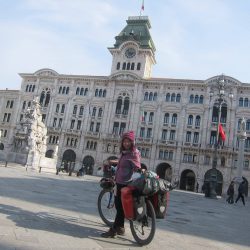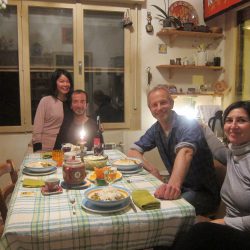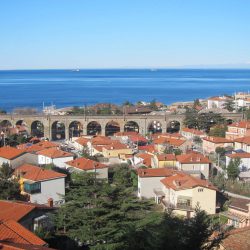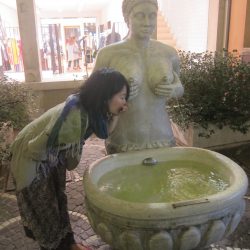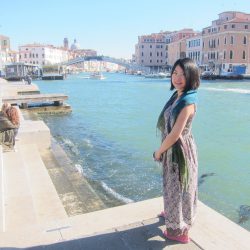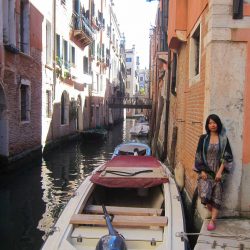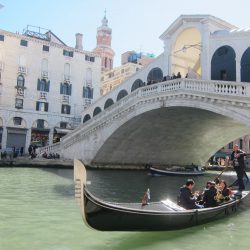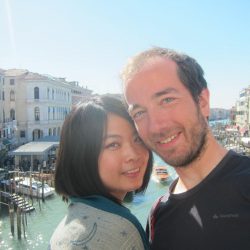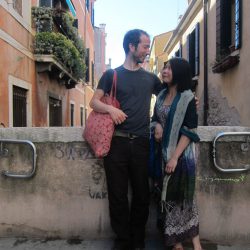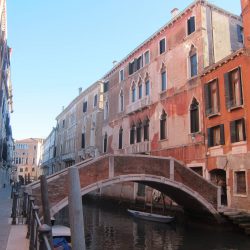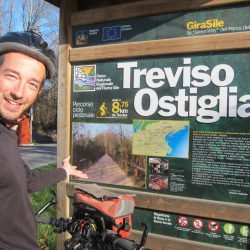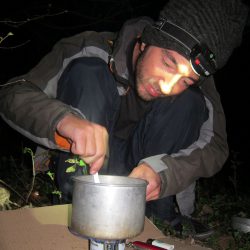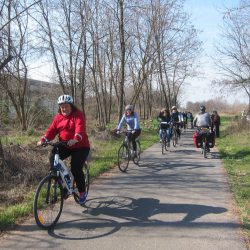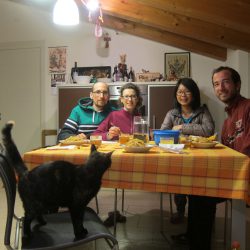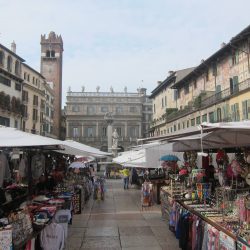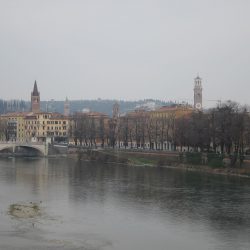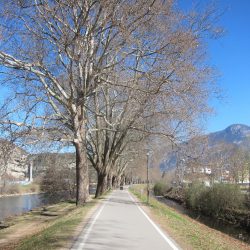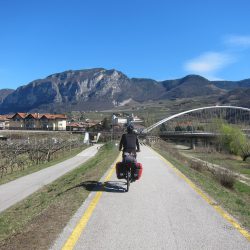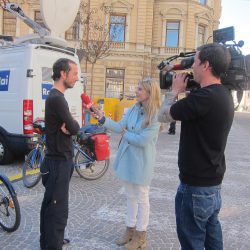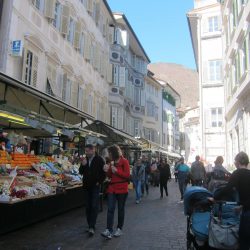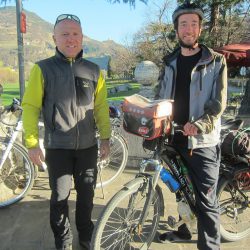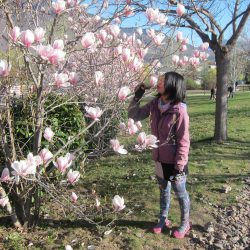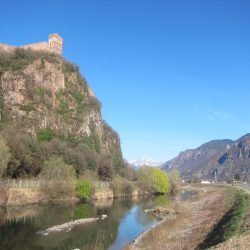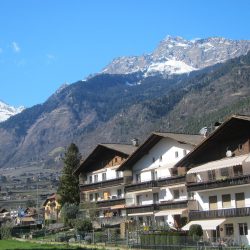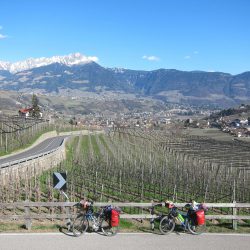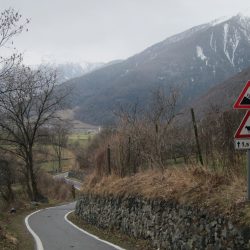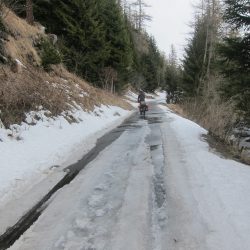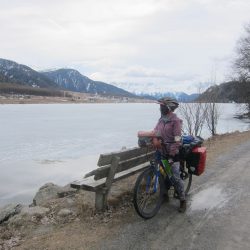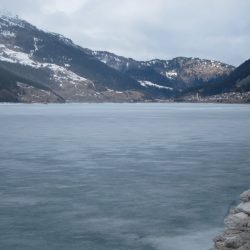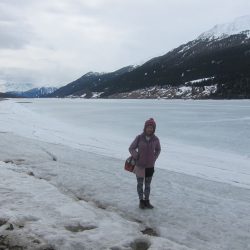Italy, a country that is immediately associated with its history and food. We had plenty of reasons to look forward to cycling here and, in the end, even more reasons to return one day. The hospitality and the excellent bicycle infrastructure were things we didn’t expect.
Photos by Yuily, text by Stephan
Trieste
Still on the Slovenian side of the border, I noticed an interesting track on my map: A track with long, wide turns twisting through the hills. This had to be an old train track. I convinced Yuily to take a chance and ride to the start of it, where a man confirmed that this track goes all the way to the center of Trieste. Awesome!
I read much about these old train lines: As trains were the only fast transportation until the 1900s, train tracks have been built everywhere in industrialized Europe. As people then switched to cars and buses became cheaper than trains, smaller lines got abandoned. But the smooth gradients make train lines excellent cycle paths: Just remove the track, lay some gravel or tarmac and bam, you got a new cycle path. Here, we could enjoy one with great views all the way to Trieste without ever coming in contact with the traffic on the road.
We got some sightseeing in the city done before meeting our host Mauro. His house was on a very steep hill in the suburbs, so we were completely spent arriving there, looking very much forward to our first rest day since Split. Mauro and his wife were excellent hosts. I made pasta for him at lunch, which he very much aprooved of. So, if an Italian likes my pasta, it must be really good. I was proud.
- Rail trail
- Trieste
- Our host Mauro
- Suburbs of Trieste
On the Po plain to Venice
Even though we could see the Alps mountains from his window, we could look forward to some flat riding days. We would head west for now on the vast Po plains toward Venice. The city was so close on our route that we couldn’t pass on it. Unfortunately, finding a host in the city itself proved too difficult, but with some luck we found Fabrizio in the nearby city of Treviso more than willing to host us.
In most of the trip, cycling infrastructure was nonexistant. China sometimes had good cycle lanes in the cities, mostly filled with scooters, but Italy was really the first country on our entire journey that had some good cycling infrastructure. Many cycling lanes would inexplicably end, but we could see efforts being made to expand them. Into Teviso, we could follow a wonderful network right up to the main station.
Fabrizio was great, treating us drinks, excited to hear about our stories, and willing to store our luggage while we were off to Venice the next day by train. The historic city doesn’t allow bicycles (or anything with wheels in fact) on its streets, so the train made more sense. And what a fantastic place it is. Completely built on the water, largely unchanged since 400 years, once the trade capital Europe. History was apparent everywhere we went, and we went a long way making our feet sore. The historic city is massive and for much of its time it was one of the world’s largest cities.
- Boobs water
- Having a beer with our host
- Venice
- Venice
- Venice Rialto Bridge
- Venice
- Venice
- Venice
We had a nice evening with Fabrizio again, setting off the next day further west. We were in for another treat: As we crossed what looked like a railway track on the map, we realized that it had already been converted into a cycling trail. A cycling trail that went arrow-straight in the direction we needed to go. We could spend most of the two days it took us to Verona on this awesome trail, camping beside it and just never worrying about traffic or directions. In the small town of Zevio, Andrea, a warmshowers host, instantly replied to my spontaneous request and let us stay for two nights. The hospitality we received in Italy so far was amazing and unconditional, it even made me reminiscent of Iran.
- Another Rail Trail!
- Cooking on a self made alcohol stove
- People out cycling
- Andrea
Into the Alps
So far the riding in Italy had all been flat, but we always saw the mighty Alps to our right. Now in Zevio, we reached the Adige river, which we would follow all the way to its source in these mighty mountains. Well, mighty is maybe too strong as a word: Compared to the mountains we had behind us in Asia, topping 4.800 m passes, the Alps were mere hills with the 1.500 m Reschenpass ahead of us. But damn, even compared to some of the mightiest mountains of the world, the Alps are still extraordinarily pretty. As we left the city of Verona, the rock faces to our left and right became larger and larger and eventually we started seeing awesome snow-capped peaks.
The bicycle paths continued to be excellent, following the river, staying on a flatter path than the road and generally free of intersections. Cycling is a big thing in Italy and we saw many people out of road bikes with angry faces trying to go as fast as possible. One man was curious about us and we chatted away while riding. It turned out he was from Tunisia, had a life-long dream to live in the US, but instead found paradise here, in the city of Bolzano.
- Verona
- Verona
- Cycle trail along the Adige
- Excellent
There were other reasons for me to look forward to Bolzano and the surrounding region of South Tyrol, close to Austria: It’s home to Tyrolean people, who traditionally speak German. By crossing into the province, all the signs became bilingual in German and Italian and I could start hearing more and more German around me. For the first time in over two years and on this whole trip, I could speak the language of the region, which made me a very happy man, even though the dialect of German here was particularly funky and hard to understand for me.
Not just the German-ness of Bolzano amazed me, but it is also a very pretty city. In Spring, all the flowers were in blossom and the peaks around had snow on them, and to top it all off the amount of cycling lanes would even impress a Dutch. As we arrived, we unfortunately found out that our host canceled on us, but messaging a few more the same evening, we quickly found ourselves a place to stay, with multiple offers of help. The Italian hospitality seemed to continue here.
- German signage!
- German language TV!
- Bolzano
- Bolzano
- Bolzano
- Our host
- Cycling trails in Bolzano
- Spring flowers
Frozen lakes
The main route through the Alps leads over the Brenner pass, but we were aiming for the more scenic, slightly higher Reschen pass, close to the border tri-point Austria-Italy-Switzerland. The valley had been mostly flat so far, but after passing Merano we were thrown into a series of switchbacks on the bike trail, bringing us quickly up in altitude. The climb stretched over 100 km, with short, steep inclines and long, flat sections inbetween. The entire valley was covered in what first looked like vineyards to us, but on seeing some apple factories, it became obvious that they are apple farms.
- Passing a castle
- Tyrolean architecture
- Looking down on Merano
- Apple farm
The weather turned colder and more rainy as we climbed and we began to see bits of leftover snow. Luckily we managed to find a shelter for camping as we prepared for the last bit of climbing to the pass, and probably the most spectacular bit as we would pass two lakes, Haidersee and Reschensee. After a steep climb we arrived at the first one, and were surprised to find it mostly frozen. Spring had truly arrived in northern Italy, but here in the high Alps winter remained for now. We kept following the excellent bike paths around the Haidersee and up to the Reschensee, very close to the pass.
This lake had tourist value, as when it was dammed, a village was flooded with it. Most of the houses had been deconstructed prior to the flooding, except the church tower, which is now poking out of the lake by itself. Due to the whole lake still being frozen, it created a very scenic image with the mountain backdrop, quite romantic to be honest. I used this opportunity to propose to Yuily once again that I want to marry her. She said yes.
- Cycle trail with 19% incline!
- Cycle trail with snow!
- Haidersee
- Reschensee
- Reschensee
- Church tower in the lake
The pass and the border with Austria was right behind the lake. It was a nice and fitting finish for a country we absolutely loved and come to value as one of our favorites, that we want to return to.
Previous: West Balkan

